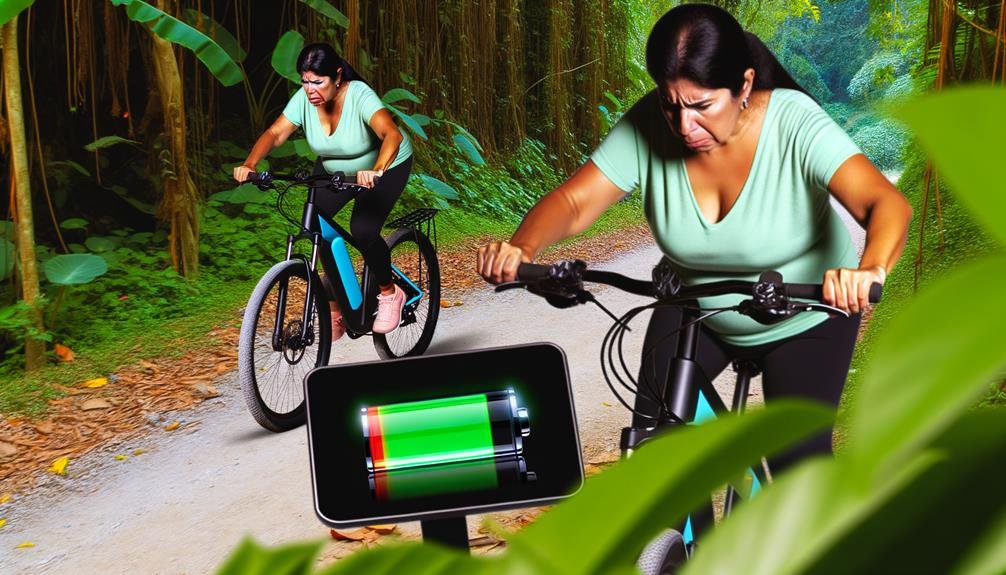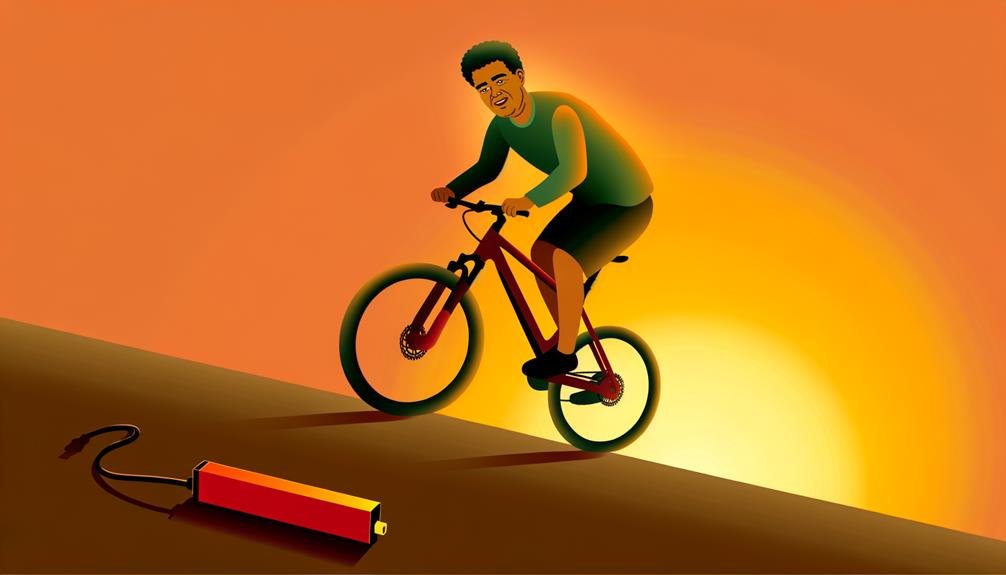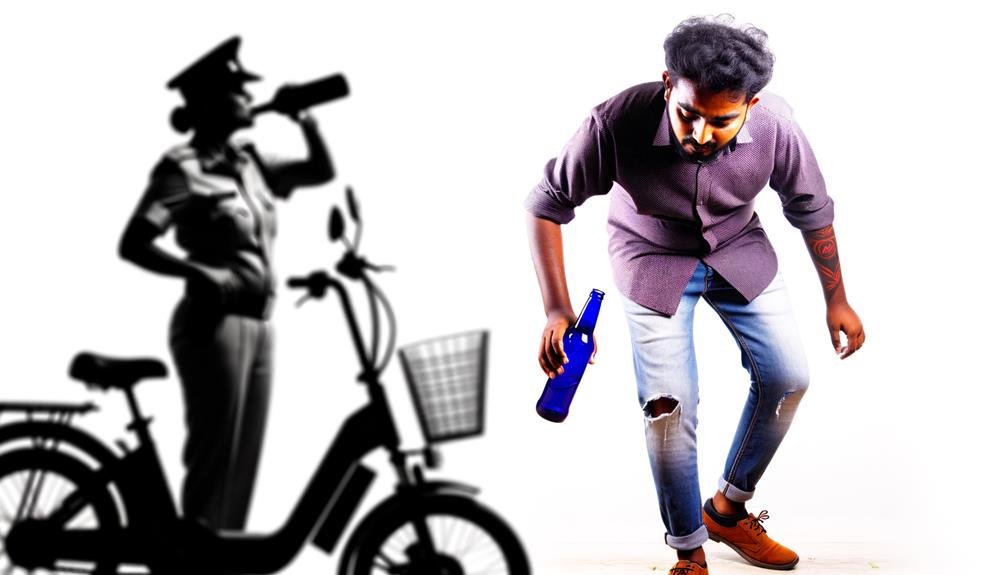Charles Miller is a veteran bike enthusiast with over 12 years of experience dealing with bikes as a mechanic. Despite immense love and expertise for...
As the sun dances on the crest of a hill and the wind whispers through a forest, one might not initially associate these poetic scenes with the buzzing mechanics of an ebike. Yet, there's an intriguing question that unites these disparate elements: can you ride an ebike without power?
We've often pondered this, and it's a subject worth investigating. What happens when the battery drains or isn't available? Is it feasible to pedal an ebike like a traditional bike, or does the added weight of the motor and frame make it an impossible task?
Stick around as we dive into the mechanics of ebikes and explore the potential of pedal power.
Key Takeaways
- Riding an ebike without power requires increased physical effort, especially uphill.
- Properly adjusting gears can make the ride smoother when riding without a battery.
- The weight of the motorized system and frame contribute to the increased effort when riding without power.
- Riding without power allows continued use of the ebike when the battery is dead.
Understanding Ebike's Mechanics
Delving into the mechanics of ebikes, it's crucial to understand that these machines can indeed be ridden without their battery, albeit with increased physical effort, particularly when tackling uphill terrains. When you ride an ebike without its battery, the weight of the motorized system and the frame contribute to the increased effort required. This doesn't damage the bike or the battery, but it does affect the riding experience.
The ebike's type of motor also plays a significant role in its performance without power assist. Ebikes with hub motors offer less resistance compared to those equipped with direct-drive motors or cranks. Therefore, your speed and distance when riding an electric bike without the battery might be affected by the type of motor installed.
In addition, the use of gears can make a significant difference in the smoothness of your ride. Properly adjusting your gears when pedaling uphill or on flat surfaces can ease the strain and make the ride more enjoyable.
The Role of Ebike's Battery
Shifting our focus to the battery, its role is paramount in the overall ebike experience, not just in providing power but also influencing the bike's weight and rideability, especially when it's not in use. The e-bike battery is often unappreciated until it's gone. You can indeed ride an e-bike without a battery, but the experience changes dramatically.
Consider these factors:
- Riding without a battery won't damage the eBike, providing peace of mind when battery power is absent.
- The added weight from the battery, motor, and frame makes the eBike heavier than regular bikes. This affects your biking experience when riding without power assist.
- Ebikes with hub motors offer less resistance than those with direct-drive motors, influencing your ride's speed and distance without battery power.
- Using gears wisely can make the ride smoother when riding an e-bike without a battery. It's crucial considering the effort required doubles or even triples.
- Regularly recharging and cleaning battery contacts and cavities before storage maintains functionality, ensuring a robust Ride Without power when needed.
In essence, the battery's role goes beyond power provision—it shapes your entire biking experience.
Pedaling Ebike Without Power

When it comes to pedaling an eBike without power, the effort required becomes noticeably greater, especially when tackling uphill routes, due to the lack of power assistance. Riding an eBike without the aid of its electric motor can be a strenuous task, akin to pedaling a standard bicycle uphill with a heavy load. The additional weight comes from the eBike frames and components, designed to support the motor and battery system.
Now, you may wonder: Can you remove the battery to make the task easier? While removing the battery indeed reduces weight, it doesn't necessarily equate to less resistance. The motor, when unpowered, can still create a form of mechanical resistance, making the eBike harder to pedal than a regular bicycle.
Dealing with a dead battery? Don't fret. Pedaling your eBike without power won't damage your bike or its battery. However, remember that an eBike is inherently heavier than a standard bicycle. So, be prepared for a workout!
Lastly, it's crucial to keep the battery cavity clean and recharge the battery before storing to prolong its lifespan.
Speed Limitations Without Battery
Let's consider the speed limitations of an eBike without its battery; although you can still ride it, the effort required increases significantly, particularly on uphill routes, and the speed you can achieve depends largely on the bike's resistance and weight.
Riding an eBike without power isn't a walk in the park. When the battery hits 0%, or if you decide to ride with a flat battery, the bike essentially becomes a manual bicycle. It's possible, but demands more energy from the rider. Here are some factors to keep in mind:
- The direct drive system of the eBike adds resistance, making it harder to pedal without power.
- The eBike, even without its battery, is heavier than a regular bike.
- You'll still need to adhere to the 49 km/h speed limit for bicycles.
- Uphill routes will be more challenging without the battery's assistance.
- Maintaining the battery cavity is crucial. Even without the battery, it should be clean and debris-free.
Riding an eBike without power may not be the most convenient, but it's certainly possible. Just remember, it's a different experience from riding with a fully charged battery.
Pros and Cons of Battery-Free Riding

Navigating the terrain of battery-free riding, we uncover both advantages and drawbacks that significantly impact the eBike experience.
Riding your electric bike without power doesn't stop you from enjoying your journey. Whether you're tackling a mountain trail or making a trip to the local shop, leaving the battery behind offers an interesting perspective. However, keep in mind that ebikes weigh more than traditional bikes, which can affect your ride.
Here are the pros and cons of battery-free riding, captured in a table:
| Pros | Cons | Considerations |
|---|---|---|
| Continued use when battery is dead | Requires double or triple the effort | Health and age |
| Makes the eBike lighter and easier to handle | Bike feels heavier due to tougher chassis and motorized system | The type of terrain you'll be riding on |
| Useful for travelling by air or mountain biking with chairlift access | Keeping a spare battery for longer rides | |
| Offers a physical challenge and increases fitness | The weight and resistance could affect speed and ride distance | |
| Won't damage the bike or batteries | The need for regular fitness |
Personal Experiences of Power-Free Ebiking
Drawing from our collective experiences, we've found that riding an eBike without power lends itself to a unique, albeit challenging, biking experience. It mightn't be the first choice for many people, but it's an option worth considering.
Here are some of our observations:
- Mountain biking becomes an intense workout. Without the assistance of the motor, climbing steep trails requires significant pedal power. Even with an aluminum alloy mountain bike, the effort is noticeable.
- On flat terrains, a power-free eBike feels similar to a regular bike. Steel frames add a bit more weight but it's manageable.
- In crowded urban areas, getting around on an eBike without power can be slower due to the bike's additional weight. However, it's still feasible.
- People have mentioned the silent operation when riding power-free, enabling them to enjoy their surroundings more.
- Even without power, the eBike can still provide a smooth ride, thanks to its robust construction and design.
Essential Tips for Battery-Less Ebike Riding

To optimize your power-free eBike experience, we've compiled several essential tips that will help you navigate different terrains and situations with relative ease. Regardless of the reasons riders choose to go battery-less, it's important to remember that an eBike's motor weighs significantly more than a regular bike's. Therefore, you'll need to make certain adjustments to maintain control and stability.
One of the key considerations is weight distribution. Ensure the cargo area is well-balanced. This could entail rearranging your belongings or even opting for a lighter load. Also, take into account the weight limits of your eBike especially when biking with chairlift access.
Check the condition of your tires regularly. Properly inflated tires can ease the strain on your legs, making pedaling a bit easier.
Here's a quick guide to help you:
| Essential Tips | Description |
|---|---|
| Weight Distribution | Balance your cargo area, and mind the weight limits. |
| Tire Condition | Regularly inflate your tires for easier pedaling. |
| Chairlift Access | Consider this when planning biking routes. |
| Motor Weight | Remember it's significantly heavier than a regular bike's. |
| Adjustments | Make necessary tweaks for control and stability. |
Frequently Asked Questions
Can You Ride an Ebike With the Motor Off?
Yes, we can ride an eBike with the motor off. It'll increase pedalling resistance, affect performance comparison, but could enhance health benefits. It won't impact motor maintenance, battery lifespan or power efficiency significantly.
Can Electric Bikes Be Used Manually?
Yes, we can use electric bikes manually. Though it increases pedaling difficulty, it boosts physical benefits and battery lifespan. Manual speed depends on our efficiency and gear mechanism. Regular maintenance is essential for a smooth ride.
Do Electric Bikes Need Electricity?
Yes, like a traditional bike, we can ride an eBike without electricity. However, it's heavier and requires more effort. It's an eco-friendly option that conserves power, extends battery lifespan, but lacks the pedal assist feature.
Can You Ride an Electric Bike Without Pedals on the Road?
Yes, we can ride an eBike without pedals on the road. However, road regulations, rider safety, and legality issues must be considered. Unlike traditional bicycles, pedal-free biking alters the electric bike design significantly.
Conclusion
So, sure, we can cycle our eBikes battery-free, but be braced for a bit of a bumpy ride. The weighty wheels will work us out well and while we won't whisk away at warp speed, we'll still get where we're going.
But bear in mind, it's best to bring the battery back before long, lest we lose the luxury of our lovely, low-effort electric assist.
In essence, eBikes bring the best of both worlds – pedal power and electric ease.

Charles Miller is a veteran bike enthusiast with over 12 years of experience dealing with bikes as a mechanic. Despite immense love and expertise for his Tacoma, he rides his Trek Ebike more. Anytime you meet him, you’ll either hear him talking about Bikes, or writing about all things bikes and cars on this blog.
More Posts


